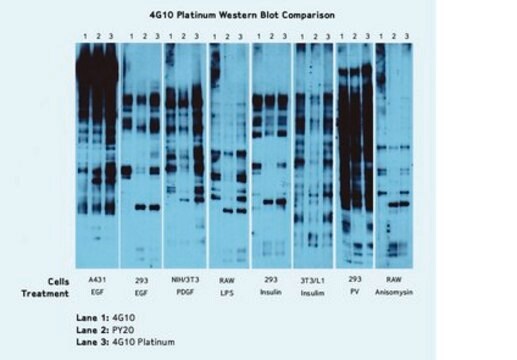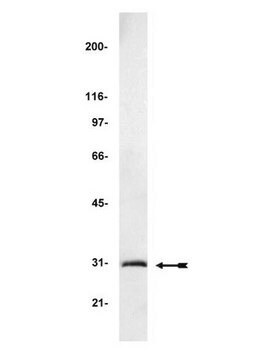16-452
4G10® Platinum, Anti-Phosphotyrosine Antibody, Biotin Conjugate
clone 4G10®, Upstate®, from mouse
Sign Into View Organizational & Contract Pricing
All Photos(1)
About This Item
UNSPSC Code:
12352203
eCl@ss:
32160702
NACRES:
NA.41
Recommended Products
biological source
mouse
Quality Level
conjugate
biotin conjugate
antibody form
purified antibody
antibody product type
primary antibodies
clone
4G10®, monoclonal
species reactivity (predicted by homology)
all
manufacturer/tradename
Upstate®
technique(s)
western blot: suitable
isotype
IgG2bκ
shipped in
wet ice
target post-translational modification
unmodified
Gene Information
human ... PID1(55022)
General description
The development of the anti-phosphotyrosine, clone 4G10 in 1989 was a monumental discovery for researchers. 4G10 was the first and best single monoclonal antibody for the detection tyrosine phosphorylation. 4G10 is well known for its sensitivity and its ability to detect multiple tyrosine phosphorylations on numerous substrates. It has been validated by thousands of scientific and medical researchers in virtually every application and tyrosine target over the past 2 decades. Now Millipore has made the best even better with 4G10 Platinum. We pooled 4G10 with the next most highly regarded anti-phosphotyrosine, clone PY20, to make 4G10 Platinum. PY20 itself is a very poor substitute for 4G10, but its additive effect allow for a greater level of detection on more substrates that even 4G10 alone is capable.
Immunogen
The immunogen for 4G10 was phospho-tyramine coupled to KLH, while the immunogen for PY20 was phosphotyrosine conjugated to a carrier protein.
Application
4G10 Platinum, Anti-Phosphotyrosine, Biotin Conjugate detects levels of Phosphotyrosine proteins & has been published & validated for use in IP.
Quality
Western Blot Analysis:
A dilution of 1:1000-2000 of this antibody detected tyrosine-phosphorylated proteins in a modified RIPA lysate from human HEK293 cells treated with 100 nM insulin.
A dilution of 1:1000-2000 of this antibody detected tyrosine-phosphorylated proteins in a modified RIPA lysate from human HEK293 cells treated with 100 nM insulin.
Target description
Varies
Physical form
100 μL of a proprietary mixture of biotin conjugated, protein G purified mouse monoclonals 4G10 (IgG2bκ) and PY20 (IgG2b) in PBS, pH 7.4 with 0.05% sodium azide.
Storage and Stability
Stable for 6 months at 2-8°C from date of shipment. For maximum recovery of product, centrifuge the vial prior to removing the cap.
NOTE: DO NOT FREEZE.
NOTE: DO NOT FREEZE.
Legal Information
4G10 is a registered trademark of Upstate Group, Inc.
UPSTATE is a registered trademark of Merck KGaA, Darmstadt, Germany
Not finding the right product?
Try our Product Selector Tool.
Storage Class Code
12 - Non Combustible Liquids
WGK
WGK 2
Flash Point(F)
Not applicable
Flash Point(C)
Not applicable
Certificates of Analysis (COA)
Search for Certificates of Analysis (COA) by entering the products Lot/Batch Number. Lot and Batch Numbers can be found on a product’s label following the words ‘Lot’ or ‘Batch’.
Already Own This Product?
Find documentation for the products that you have recently purchased in the Document Library.
Ren Liu et al.
Blood, 116(2), 297-305 (2010-05-06)
Axl is an oncogenic receptor tyrosine kinase that plays multiple roles in tumorigenesis and metastasis of many cancers. This study is the first to demonstrate that Axl is induced in Kaposi sarcoma and Kaposi sarcoma herpesvirus (KSHV) transformed endothelial cells.
Shalini Chaturvedi et al.
International journal of biological sciences, 9(10), 1099-1107 (2013-12-18)
A novel assay was developed to measure ratio of p-FMS (phospho FMS) to FMS using the Meso Scale Discovery(®) (MSD) technology and compared to the routinely used, IP-Western based approach. The existing IP-Western assay used lysed PBMCs (Peripheral Blood Mononuclear
Philippe Foubert et al.
The Journal of clinical investigation, 117(6), 1527-1537 (2007-05-19)
Endothelial progenitor cell (EPC) transplantation has beneficial effects for therapeutic neovascularization; however, only a small proportion of injected cells home to the lesion and incorporate into the neocapillaries. Consequently, this type of cell therapy requires substantial improvement to be of
The carboxyl terminus controls ligand-dependent activation of VEGFR-2 and its signaling
Meyer, R. D., et al
The Journal of Biological Chemistry, 279, 735-742 (2004)
Keigo Nishida et al.
The Journal of cell biology, 170(1), 115-126 (2005-07-07)
The aggregation of high affinity IgE receptors (Fcepsilon receptor I [FcepsilonRI]) on mast cells is potent stimulus for the release of inflammatory and allergic mediators from cytoplasmic granules. However, the molecular mechanism of degranulation has not yet been established. It
Our team of scientists has experience in all areas of research including Life Science, Material Science, Chemical Synthesis, Chromatography, Analytical and many others.
Contact Technical Service




